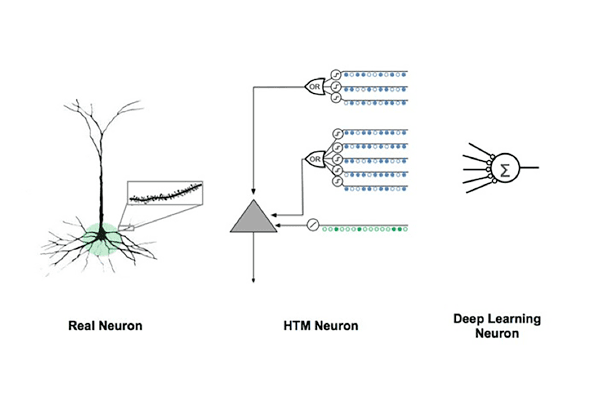| Authors | J. Hawkins & S. Ahmad |
| Journal | Frontiers in Neural Circuits, 10 (2016) 1–13, doi:10.3389/fncir.2016.00023 |
| Online | Read or Download this Paper |
| Published | March 30, 2016 |
All sensory inputs and all behavior comprise complex sequences of patterns. In this paper we propose that the most fundamental operation of all neocortical tissue is learning and recalling sequences of patterns, what Karl Lashley famously called “the most important and also the most neglected problem of cerebral physiology”. We first show how a biologically detailed model of pyramidal neurons with thousands of synapses and active dendrites can learn transitions of patterns. We then show how a network of such neurons can form a powerful and robust sequence memory. In the paper we also describe various properties of the model and compare it with several other neural network models. Given the prevalence and similarity of pyramidal neurons throughout the neocortex, and the importance of sequence memory, we propose that this form of sequence memory could be a universal property of all neocortical tissue.
 The HTM neuron models biological neurons unlike most artificial neural networks
The HTM neuron models biological neurons unlike most artificial neural networks
Frequently asked questions
Q. What was the purpose of this study?
The purpose of this study was to explore and understand how sequences are modeled in the neocortex. We believe sequence modeling is a fundamental property underlying intelligent behavior, and that it must be occurring everywhere in the neocortex. This study is part of our larger effort to reverse engineer the
neocortex, and improve our overall understanding of how the brain learns.
Q. What are the key takeaways?
- Biological neurons are significantly more complex than the simple models used in most artificial neural networks. Understanding these differences is important.
- A network incorporating more realistic pyramidal neurons can learn complex sequences in a surprisingly robust and flexible manner. The model learns in a completely unsupervised manner and is far more adaptable than traditional machine learning techniques.
- Our model incorporates a large number of findings from experimental neuroscience. As such the model is able to make detailed predictions that we hope can guide future experimental research.
Q. How does this research differ from other studies?
There are two key differences:
- Most models that are used today in Machine Learning differ greatly from the model offered in this paper. They are mathematically derived and have very little in common with biology.
- Unlike most models in Computational Neuroscience, the algorithm described here is not restricted to a small set of neuroscience experiments. The algorithm has been tested and validated in several commercially valuable tasks, such as anomaly detection on streaming data.
Q. How were the simulations conducted?
For this paper, we wrote simulation code in Python to demonstrate various properties of sequence memory. We used the reference HTM implementation available in the open source project NuPIC.
Q. Can I replicate these simulations?
Yes! In keeping with Numenta’s open research philosophy, the source code for replicating the graphs in the paper can be found here. We also welcome questions and discussion about the paper on the HTM Forum.
Q. How will this paper make contributions in neuroscience?
This paper offers a computational model of pyramidal neurons and an explanation of how a neuron uses thousands of synapses and computationally active dendrites to learn sequences. The paper also lists several detailed predictions that can be used to guide experimental neuroscientists interested in studying sequence memory.
Q. How does this paper make contributions in machine learning?
This research offers a new sequence memory algorithm that machine learning experts can test, experiment with, and verify. We have already created software that demonstrates how the theory works in several applications. We believe others can use this algorithm to build a broad range of applications.
Q. What are the key machine learning properties of the model?
The model described in the paper demonstrate the following key properties:
- On-line learning
- High-order sequences
- Multiple simultaneous predictions
- Local unsupervised learning rules
- Robustness
- Use of sparse distributed representations
A companion paper, which appears in Neural Computation, November 2016, Volume 28, provides more detailed machine learning comparisons of the above properties.
Q. Where can I find out more?
The HTM Forum is a great resource for further questions and discussion on HTM theory. The authors of this paper are active participants in the forum.
Q. What is next for this research?
This research forms the foundation for our overall goal of reverse-engineering the neocortex. Our current research builds on this theory and focuses on sensorimotor learning, how the neocortex learns and builds a model of the world through movement.
